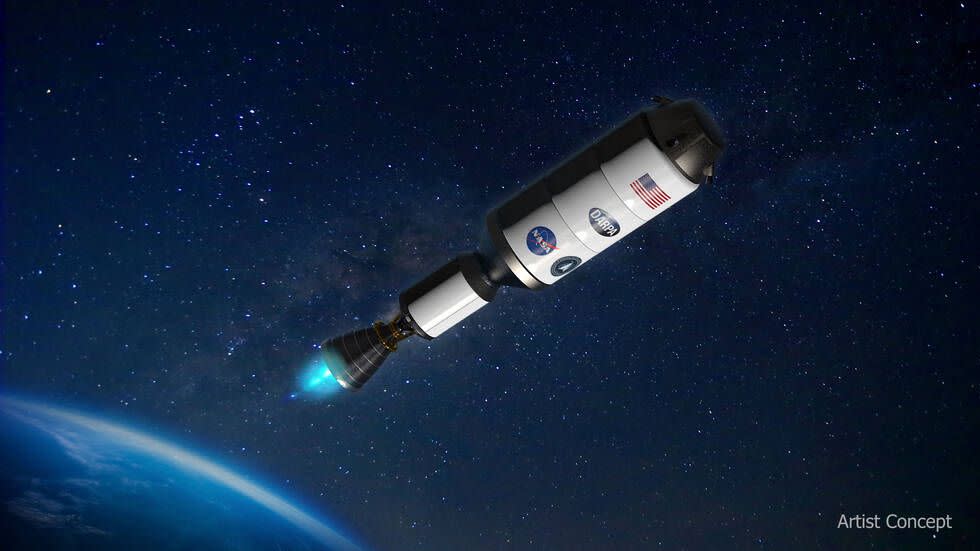The Nuclear Thermal Rocket That Could Get Us to Mars in Just 45 Days

NASA has hired Lockheed Martin to design, build, and test a nuclear-powered rocket for space travel.
The technology could speed up a manned trip to Mars from the current seven-month minimum to as few as 45 days.
A nuclear fission reactor would power the rocket’s engine for nuclear propulsion.
NASA is going nuclear in the agency’s effort to clip time off a manned trip to Mars. The latest plan involves NASA reviving 70-year-old nuclear thermal technology research and partnering with contractors to start testing a nuclear-powered rocket in space as soon as 2027.
NASA and the U.S. Department of Defense’s Defense Advanced Research Projects Agency (DARPA) contracted Lockheed Martin to design, build, and test nuclear thermal rocket technology for a shorter, faster trip to the Red Planet. The rocket is also expected to operate with twice the efficiency as conventional chemical rockets, which combine fuel and an oxidizer for combustion power.
“Working with DARPA and companies across the commercial space industry will enable us to accelerate the technology development we need to send humans to Mars,” Pam Melroy, NASA deputy administrator, says in a statement. “This demonstration will be a crucial step in meeting our Moon-to-Mars objectives for crew transportation into deep space.”
Lockheed Martin will lead spacecraft design, integration, and testing of the roughly $500 million project, and BWX Technologies will design and build the nuclear fission reactor to power the engine.
Tabitha Dodson, DARPA program manager for the project, says in a statement that the DRACO project (Demonstration Rocket for Agile Cislunar Operations) “aims to give the nation leap-ahead propulsion capability.”
A nuclear thermal rocket could achieve high thrust—much like chemical propulsion—but is up to three times more efficient. This means that instead of the seven month-minimum it now takes to get to Mars, a nuclear-powered trip would only take 45 days. And going to Mars in 45 days isn’t the only benefit, as NASA is also looking for an efficient Earth-to-Moon connection.
“In order for our country, for our species, to further explore space, we need changes in more efficient propulsion,” Kirk Shireman, Lockheed Martin’s vice president for lunar exploration campaign, said in a press conference, according to the Washington Post. “Higher thrust propulsion is really, really important. And I think we’re on the cusp of that here.”
The United States started down the nuclear rocket path in the 1950s, but the idea was scraped during a 1970s budget cut. The DRACO program aims to build on that early research, but with a new fuel option for fewer logistical hurdles. Using a high-assay, low-enriched uranium fuel, the fission-based reactor can split apart atoms, heat up liquid hydrogen, and shoot that high-temperature gas through an engine nozzle for the needed thrust.
The greater efficiency from a nuclear thermal rocket not only slashes transit time, but also reduces astronaut risks and cuts down on payload needs for both supplies and systems.
One challenge yet to be overcome, according to Live Science, is the need to heat the hydrogen to 4,400°F while also storing it a minus-420°F. “This is just as much a demonstration of on-orbit storage of cryogenic liquid hydrogen as it is a demo of the nuclear thermal rocket,” Dodson says.
In the hoped-for 2027 test launch, the engine’s fission reactor will stay turned off—for obvious safety reasons—until the rocket reaches its designated orbit. The U.S. Space Force will provide a launch vehicle to take the test vessel into space.
The initial DRACO test plans to send the craft at least 435 miles and no more than 1,240 miles into space. It has no planned maneuvers, and will instead allow the vehicle’s reactor to use the new fuel and collect data along the way. With a planned two months of liquid hydrogen stored on the craft, crews may also test, according to Space News, the possibility of an in-space refueling.
“We’re going to put this together,” Shireman told reporters, according to Live Science, “we’re going to fly this demonstration, gather a bunch of great data and really, we believe, usher in a new age for the United States [and] humankind, to support our space exploration mission.”
You Might Also Like

